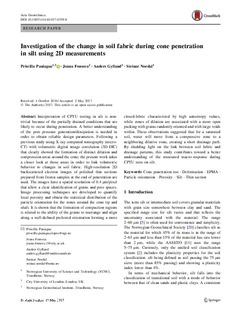| dc.contributor.author | Paniagua Lopez, Ana Priscilla | |
| dc.contributor.author | Fonseca, Joana | |
| dc.contributor.author | Gylland, Anders Samstad | |
| dc.contributor.author | Nordal, Steinar | |
| dc.date.accessioned | 2017-08-24T06:52:37Z | |
| dc.date.available | 2017-08-24T06:52:37Z | |
| dc.date.created | 2017-08-07T15:36:58Z | |
| dc.date.issued | 2017 | |
| dc.identifier.citation | Acta Geotechnica. 2017, 1-14. | nb_NO |
| dc.identifier.issn | 1861-1125 | |
| dc.identifier.uri | http://hdl.handle.net/11250/2451660 | |
| dc.description.abstract | Interpretation of CPTU testing in silt is non-trivial because of the partially drained conditions that are likely to occur during penetration. A better understanding of the pore pressure generation/dissipation is needed in order to obtain reliable design parameters. Following a previous study using X-ray computed tomography (micro-CT) with volumetric digital image correlation (3D-DIC) that clearly showed the formation of distinct dilation and compression areas around the cone; the present work takes a closer look at those areas in order to link volumetric behavior to changes in soil fabric. High-resolution 2D backscattered electron images of polished thin sections prepared from frozen samples at the end of penetration are used. The images have a spatial resolution of 0.4 µm/pixel that allow a clear identification of grains and pore spaces. Image processing techniques are developed to quantify local porosity and obtain the statistical distribution of the particle orientation for the zones around the cone tip and shaft. It is shown that the formation of compaction regions is related to the ability of the grains to rearrange and align along a well-defined preferred orientation forming a more closed-fabric characterized by high anisotropy values, while zones of dilation are associated with a more open packing with grains randomly oriented and with large voids within. These observations suggested that for a saturated soil, water will move from a compressive zone to a neighboring dilative zone, creating a short drainage path. By shedding light on the link between soil fabric and drainage patterns, this study contributes toward a better understanding of the measured macro-response during CPTU tests on silt. | nb_NO |
| dc.language.iso | eng | nb_NO |
| dc.publisher | Springer Verlag | nb_NO |
| dc.rights | Navngivelse 4.0 Internasjonal | * |
| dc.rights.uri | http://creativecommons.org/licenses/by/4.0/deed.no | * |
| dc.title | Investigation of the change in soil fabric during cone penetration in silt using 2D measurements | nb_NO |
| dc.type | Journal article | nb_NO |
| dc.type | Peer reviewed | nb_NO |
| dc.description.version | publishedVersion | nb_NO |
| dc.source.pagenumber | 1-14 | nb_NO |
| dc.source.journal | Acta Geotechnica | nb_NO |
| dc.identifier.doi | 10.1007/s11440-017-0559-8 | |
| dc.identifier.cristin | 1484623 | |
| dc.description.localcode | This article is distributed under the terms of the Creative Commons Attribution 4.0 International License (http://creativecommons.org/licenses/by/4.0/), which permits unrestricted use, distribution, and reproduction in any medium, provided you give appropriate credit to the original author(s) and the source, provide a link to the Creative Commons license, and indicate if changes were made. | nb_NO |
| cristin.unitcode | 194,64,35,0 | |
| cristin.unitname | Institutt for bygg, anlegg og transport | |
| cristin.ispublished | true | |
| cristin.fulltext | original | |
| cristin.qualitycode | 1 | |

